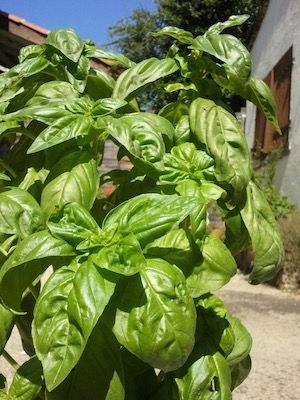BASIL
I- Nomenclature
Latin name: Ocimum basilicum L.
Family : Lamiacea
Common names: Great basil, sweet basil, Genevose basil
Etymology
The name "basil" comes from the ancient Greek "basiliskos", diminutive of "basileus" in Latin, which means "king" or "little king".
II- Legends and traditions
According to Edouard Brasey, basil was considered to be the king of snakes.
The Romans called it “blood of Saturn”. In old French texts, we find the term basilicoq.
III- Botanical description
Description: Herbaceous 20 to 40 cm, it can sometimes reach 80 cm.
The quadrangular, branched stems form a dense tuft with rather oval leaves and usually a particularly bright green.
The small white flowers grouped in whorls along the stems appear in summer.
Habitat: Originating from Asia, basil, used to heat and humidity, has thrived particularly in the Mediterranean basin since the Middle Ages.
Parts used : leaves and flowering tops
IV- Active ingredients
|
Leaves |
|
essential oil: cineol, linalol, estragol, camphor tannine |
V- Therapeutic uses
Properties
|
Leaves |
|
antispasmodic intestinal antispetic emmenagogue nervous balancing stomagic tonic |
Indications
Acne
Anguish
Bloating, gas, difficult digestion
Lack of appetite
Insomnia of nervous origin
Migraines of nervous origin
Intestinal parasites
Dosage
Internal use
Infusion: one teaspoon per cup of boiling water after each meal (digestive).
Essential oil: on a piece of sugar fights nervous gastric spasms.
Basil wine: macerate 4 tablespoons of dried basil for 3 days in a liter of wine. On the 4th day, pass, express and sweeten according to your taste. Have a drink before meals.
External use
Gargle: against mouth ulcers and inflammations in the mouth.
Essential oil: applied externally to the skin (acne).
VI- Precaution of use
Contraindication
During pregnancy, breastfeeding, in infants and young children.
Do not use for a prolonged period.



